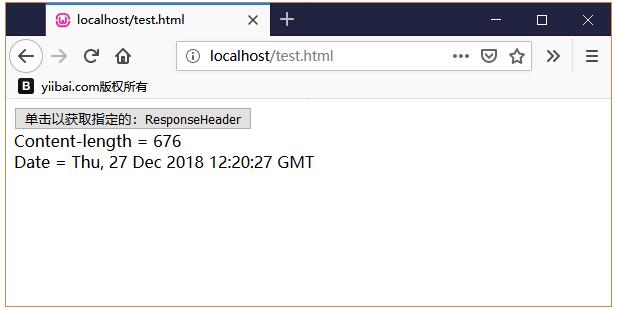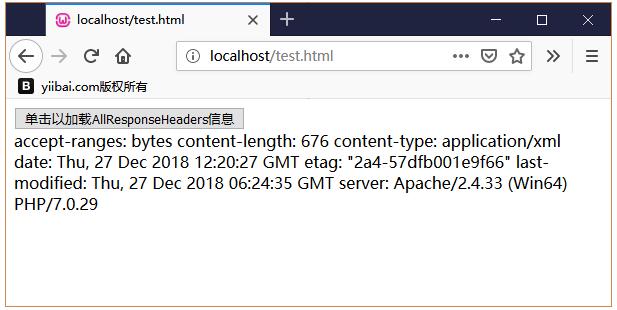XMLHttpRequest对象在网页的客户端和服务器端之间建立介质,可以由许多脚本语言(如JavaScript,JScript,VBScript和其他Web浏览器)使用,以传输和操作XML数据。
使用XMLHttpRequest对象,可以更新网页的一部分而无需重新加载整个页面,在页面加载后从服务器请求和接收数据并将数据发送到服务器。
XMLHttpRequest对象可以实例化如下 -
var xmlhttp = new XMLHttpRequest();
要处理所有浏览器,包括IE5和IE6,请检查浏览器是否支持XMLHttpRequest对象,如下代码所示 -
if(window.XMLHttpRequest) // for Firefox, IE7+, Opera, Safari, ... {
xmlHttp = new XMLHttpRequest();
} else if(window.ActiveXObject) // for Internet Explorer 5 or 6 {
xmlHttp = new ActiveXObject(Microsoft.XMLHTTP);
}
可以查看如何使用XMLHttpRequest对象加载XML文件的示例
下表列出了XMLHttpRequest对象的方法 -
| 序号 |
方法 |
描述 |
| 1 |
abort() |
终止当前的请求。 |
| 2 |
getAllResponseHeaders() |
以字符串形式返回所有响应标头,如果未收到响应,则返回null。 |
| 3 |
getResponseHeader() |
返回包含指定标头文本的字符串;如果尚未收到响应或响应中不存在标头,则返回null。 |
| 4 |
open(method,url,async,uname,pswd) |
它与Send方法共用,用于将请求发送到服务器。参数:1.method- 指定请求的类型,即GET或POST。2.url- 文件的位置。3.async-表示应如何处理请求,它是布尔值。4.uname - 用户名。5.pswd- 密码 |
| 5 |
send(string) |
它用于发送与Open方法结合的请求。 |
| 6 |
setRequestHeader() |
标头包含发送请求的标签/值对。 |
@H_404_135@
下表列出了XMLHttpRequest对象的属性 -
| 序号 |
属性 |
描述 |
| 1 |
onreadystatechange |
它是一个基于事件的属性,在每个状态的变化都会设置。 |
| 2 |
readyState |
它描述了XMLHttpRequest对象的当前状态。 readyState属性有五种可能的状态 - readyState = 0 - 表示请求尚未初始化。readyState = 1 - 设置请求。readyState = 2 - 发送请求。readyState = 3 - 请求正在处理中。readyState = 4 - 请求已完成。 |
| 3 |
responseText |
当服务器的响应是文本文件时,将使用此属性。 |
| 4 |
responseXML |
当服务器的响应是XML文件时,将使用此属性。 |
| 5 |
status |
将Http请求对象的状态作为数字给出。 例如,404或200。 |
| 6 |
statusText |
将Http请求对象的状态作为字符串。 例如,Not Found或OK。 |
@H_404_135@
文件:node.xml 的内容如下 -
<?xml version = 1.0?>
<Company>
<Employee category = Technical>
<F@R_502_6447@tName>Tianya</F@R_502_6447@tName>
<LastName>Su</LastName>
<ContactNo>0898-12345678</ContactNo>
<Email>[email protected]</Email>
</Employee>
<Employee category = Non-Technical>
<F@R_502_6447@tName>Max</F@R_502_6447@tName>
<LastName>Lee</LastName>
<ContactNo>089833990088</ContactNo>
<Email>[email protected]</Email>
</Employee>
<Employee category = Management>
<F@R_502_6447@tName>Susen</F@R_502_6447@tName>
<LastName>Wong</LastName>
<ContactNo>1010-234562350</ContactNo>
<Email>[email protected]</Email>
</Employee>
</Company>
检索资源文件的特定信息
下面的示例演示如何使用方法getResponseHeader()和属性readState来检索资源文件的特定信息。
<!DOCTYPE html>
<html>
<head>
<Meta http-equiv = content-type content = text/html;charset=utf-8 />
<script>
function getXMLHttp() {
var xmlHttp = null;
if(window.XMLHttpRequest) { // for Firefox, IE7+, Opera, Safari, ...
xmlHttp = new XMLHttpRequest();
}else if(window.ActiveXObject){ // for Internet Explorer 5 or 6
xmlHttp = new ActiveXObject(Microsoft.XMLHTTP);
}
return xmlHttp;
}
function makerequest(serverPage, myDiv) {
var request = getXMLHttp();
request.open(GET, serverPage);
request.send(null);
request.onreadystatechange = function() {
var msg = '';
if (request.readyState == 4) {
msg = 'Content-length = '+request.getResponseHeader(Content-length);
msg = msg +'<br/> Date = '+ request.getResponseHeader(Date);
document.getElementById(myDiv).innerHTML = msg;
}
}
}
</script>
</head>
<body>
<button type = button onclick=makerequest('/node.xml', 'ID')>单击以获取指定的:ResponseHeader</button>
<div id = ID>返回指定标头信息</div>
</body>
</html>
执行上面示例代码,得到以下结果 -

检索资源文件的标头信息
下面的示例演示如何使用readyState属性和getAllResponseHeaders()方法检索资源文件的头信息。
<!DOCTYPE html>
<html>
<head>
<Meta http-equiv=content-type content=text/html; charset=utf-8 />
<script>
function GetXMLHttp() {
var xmlHttp = null;
if(window.XMLHttpRequest) {// for Firefox, IE7+, Opera, Safari, ...
xmlHttp = new XMLHttpRequest();
} else if(window.ActiveXObject){ // for Internet Explorer 5 or 6
xmlHttp = new ActiveXObject(Microsoft.XMLHTTP);
}
return xmlHttp;
}
function makerequest(serverPage, myDiv) {
var request = GetXMLHttp();
request.open(GET, serverPage);
request.send(null);
request.onreadystatechange = function() {
if (request.readyState == 4) {
document.getElementById(myDiv).innerHTML = request.getAllResponseHeaders();
}
}
}
</script>
</head>
<body>
<button type = button onclick = makerequest('/node.xml', 'ID')>
单击以加载AllResponseHeaders信息</button>
<div id = ID></div>
</body>
</html>
执行上面示例代码,得到以下结果 -



